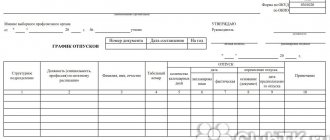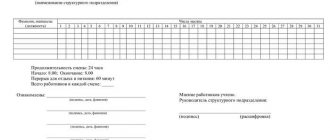What is a vacation schedule, who needs it and why?
A vacation schedule is an internal company document that takes into account the interests of the workforce and the employer. Thanks to the schedule, the continuity of the production process at the enterprise is maintained, and employees exercise their right to annual rest.
The vacation schedule is equally important for both employees and the company’s administration. The better it is compiled, the less conflicts and confusion will arise in the future regarding employees going on regular vacations.
NOTE! Mention of the vacation schedule as a document determining the order of annual rest for members of the work collective is contained in Art. 123 Labor Code of the Russian Federation.
Labor legislation does not specify for what number of employees a businessman is required to draw up this document. It is logical to assume that it is pointless for an individual entrepreneur carrying out commercial activities alone to draw up a vacation schedule. He has no one to argue with about the timing of his rest - he plans the labor process himself.
Completely different consequences arise in the absence of this document in work collectives with a larger number of workers. Statistics show that most people want to relax in the summer and early autumn. This fact poses a difficult task for the company's management - to take into account the interests of the team and not cause damage to the business. And it doesn’t matter whether 5 people work under a businessman or several thousand, you can’t do without a vacation schedule.
In addition, untimely registration of a vacation schedule can lead not only to vacation confusion, but also to material losses in the form of a fine.
NOTE! Punishment for the director of a company who ignored the requirement of labor legislation to draw up a vacation schedule is provided for under Art. 5.27 of the Administrative Code and can range from 1000 to 5000 rubles. The company will lose even more - from 30,000 to 50,000 rubles.
If the violation is repeated, the directors of the company may be disqualified for 1–3 years or punished with an increased fine of 10,000 to 20,000 rubles. A legal entity in this situation may be subject to a penalty in the amount of 50,000 to 70,000 rubles.
About additional holidays
Above we discussed basic annual paid leave. In addition, according to Article 116 of the Labor Code of the Russian Federation, there are also additional holidays. Those who are employed in dangerous and harmful work (or of a special nature), work in abnormal conditions, in the Far North, etc., as well as in some other specific cases stipulated by law, have the right to them.
Each employer, taking into account its financial and production capabilities, has every right to establish additional leaves for employees on its own initiative. The procedure for such a procedure, as well as the standard rules for drawing up a vacation schedule, is approved by a collective agreement, taking into account the opinion of the trade union organization. When calculating the total duration, the days of additional vacations are summed up with the main ones and reflected in the schedule.
Who, how and when draws up the schedule
The vacation schedule is one of the personnel documents, so responsibility for its preparation and timely approval lies with the HR specialists and the company administration.
Important! Practical situation from ConsultantPlus Do I need to approve the vacation schedule for newly created organizations in the first year of their work? This issue is not directly regulated by law. But if the creation of your organization occurs at the beginning of the year, then it is better to draw up a vacation schedule. Let us explain in more detail. For more information on this issue, see K+. Trial access to the system is free.
Until recently, all companies issued a vacation schedule using a single unified form T-7, the form of which can be downloaded for free on our website using the link below:
The 10 columns of form T-7 were filled in with the following information:
- Column 1 - name of the structural unit (office, chief mechanic department, labor protection department, financial department, etc.);
- column 2 - position according to the staffing table (director, secretary, mechanic, etc.);
- columns 3 and 4 - last name, first name, patronymic and personnel number of the employee;
- columns 5–9 - data on vacation (duration, start dates of vacation - planned and actual);
- Column 8 - the basis for changing the planned vacation dates;
- column 9 - date of proposed vacation;
- column 10 - note.
If your organization has external part-time workers, then the question may arise: should you include information about the vacation of an external part-time worker in the vacation schedule? ConsultantPlus experts gave detailed explanations on this matter. Get free trial access to the system and proceed to recommendations and possible risks.
Today, it is not necessary to use a unified form of a schedule, but the legislation does not contain a ban on the use of the usual format of this document. So the personnel service has a choice: fill out the T-7 form or develop a new document with a similar name and purpose.
The main thing is to approve the vacation schedule on time, that is, no later than two weeks before the start of the new calendar year (Article 123 of the Labor Code of the Russian Federation). That is, the schedule for 2021 should be approved no later than December 17, 2020.
After the manager approves the vacation schedule, this document must be familiarized to employees against receipt (Articles 22, 123 of the Labor Code of the Russian Federation). To do this, it is advisable to add another column to the schedule or create a statement where each employee will indicate the date of review and sign.
From 02/18/2020, the storage period for vacation schedules in the archive has been increased from one year to 3 years (Article 453 of the list, approved by order of the Federal Archives of December 20, 2019 No. 236).
IMPORTANT! Do not forget to notify the employee in writing (against receipt) about the start of the vacation no later than two weeks before it begins (clause 3 of Article 123 of the Labor Code of the Russian Federation).
Written with a pen...
Upon completion of the approval procedure for the vacation schedule, it is binding. This means that management does not have the right to postpone the deadlines specified in the document without a particularly compelling reason. And the employee undertakes to use the days allotted to him according to what is written. If there is a need for any deviations, any of them is formalized by an appropriate order with a note indicating the reason in the schedule.
If an employee is hired after the document has been approved, he is sent to rest on the basis of an additional order on drawing up a vacation schedule or on a personal application.
"Children's" nuances of the schedule
Labor legislation influences the regulation of vacation periods in the schedule. For example, the following categories of workers have the right to rest at a time convenient for them:
- spouses during their wives' maternity leave (Article 123 of the Labor Code of the Russian Federation);
- a parent or guardian working in the Far North to accompany a child under 18 years of age to another area to the place of his admission to a university or college (Article 322 of the Labor Code of the Russian Federation).
- one of the parents raising a disabled child under the age of 18 (Article 262.1 of the Labor Code of the Russian Federation);
- parents of three or more children under the age of 12 (Article 262.2 of the Labor Code of the Russian Federation).
For more details, see: “Vacation schedule: if a child of a parent with many children turns 12 next year.”
The category of “children’s” aspects of the vacation schedule also includes the mandatory consideration of the opinion on the rest period of an employee who has not reached the age of majority (under the age of 18). For this group of working employees in the Labor Code of the Russian Federation, vacation features are highlighted in a separate article. 267.
In addition to vacation benefits for workers with children, we must not forget about the restrictions. For example, paragraph 20 of the Supreme Court ruling dated January 28, 2014 No. 1 indicates the inadmissibility of simultaneous use of two or more leaves for different reasons.
For the scheduler, this means that the vacation schedule should not include vacations for employees who are on parental leave and working part-time.
What about past years?
What to do with unused vacations? Are they included in the schedule or not? Can days not used for 2 years actually expire? According to Rostrud Letter No. 473-6-0 of 2007, such leaves are included in the general schedule or are provided at the request of the employee. It is more convenient if they are reflected when drawing up a vacation schedule for the 2021 (or any other) calendar year, as this will make it possible to visualize the state of affairs with accumulated unused rest days across the entire organization.
According to the law, employees should be sent on vacation annually. Cases of transferring them to the next year are among the exceptions. Such “overdue” leave must be provided no later than 12 months after the end of the year for which it is due (Article 124). That is, drawing up a vacation schedule for 2017 implies entering into it all the “debt” for days of rest to employees for 2016.
It is prohibited to refuse to grant vacations for two years in a row, and preferential categories (minors and those working in dangerous, harmful conditions) are supposed to take vacations annually. Vacations cannot “burn out.” The employee’s rights to it are preserved, but the manager, if the fact of such savings is discovered in the event of an inspection by the labor inspectorate, can be seriously punished.
“Preferential” vacation schedule regulators
In addition to the above-mentioned “children’s” vacation nuances, the vacation schedule may take into account one more group of employees, in respect of whom the employer is obliged to agree with any rest periods they choose.
Among these employees:
- honorary donors (Law of the Russian Federation “On the donation of blood and its components” dated July 20, 2012 No. 125-FZ);
- Heroes of Russia and holders of the Order of Glory (Law of the Russian Federation “On the status of Heroes of the Soviet Union, Heroes of the Russian Federation and full holders of the Order of Glory” dated January 15, 1993 No. 4301-I);
- Heroes of Socialist Labor, Heroes of Labor of the Russian Federation and full holders of the Order of Labor Glory (law “On the provision of social guarantees to Heroes of Socialist Labor, Heroes of Labor of the Russian Federation and full holders of the Order of Labor Glory” dated 01/09/1997 No. 5-FZ);
- Chernobyl victims (Law of the Russian Federation “On the social protection of citizens exposed to radiation as a result of the disaster at the Chernobyl nuclear power plant” dated May 15, 1991 No. 1244-I);
- persons who received a certain amount of radiation in Semipalatinsk (Law “On social guarantees for citizens exposed to radiation as a result of nuclear tests at the Semipalatinsk test site” dated January 10, 2002 No. 2-FZ).
- employees of internal affairs bodies, if they have not exercised their right to the main leave provided for by the schedule (Law “On Service in the Internal Affairs Bodies of the Russian Federation and Amendments to Certain Legislative Acts of the Russian Federation” dated November 30, 2011 No. 342-FZ).
If the company practices external part-time work, the part-time employee has the right to go on vacation simultaneously with the next vacation at the main place of work (Article 286 of the Labor Code of the Russian Federation).
Find out how to properly arrange a vacation for a part-time worker here .
When drawing up a vacation schedule, the employer will have to take into account the opinion of the employee - the spouse of a military serviceman, who has the right to go on vacation during the period of time coinciding with the spouse's vacation (Law “On the Status of Military Personnel” dated May 27, 1998 No. 76-FZ).
Main operating principles
What requirements must be taken into account when drawing up a vacation schedule? It must imply the specifics of production, compliance with work technology and the principle of interchangeability of employees. The possibilities for this are laid down in the Labor Code of the Russian Federation. In order to avoid disagreements and disputes, the order of vacations with the procedure for determining it is mandatory to be prescribed in a collective agreement or other local regulatory act. For example, it is mandatory to indicate the impossibility of the head of the department and his deputy going on vacation at the same time.
Depending on the specifics of the organization, the provision of annual leave only during certain months may be recorded at the documentary level. For example, they are only in schools in the summer, otherwise the learning process may be disorganized. There are situations when it is convenient to send most of the team on vacation at once. This is often associated with seasonal ups and downs in the work of a particular production.
But in most cases, the best option is a relatively even distribution of vacations throughout the calendar year.
Vacation schedule and newcomers
When drawing up the vacation schedule for 2021, approved in December 2021, it is impossible to provide for the likely periods of rest for employees who started working after the start of the calendar year. Nevertheless, the absence of a newcomer’s planned vacation in the schedule does not relieve the administration of the obligation to provide it.
NOTE! In accordance with Art. 122 of the Labor Code of the Russian Federation, an employee who has worked for a given employer for six months has the right to leave.
In such cases, the personnel officer responsible for vacation regulations can do one of the following:
- without changing the approved schedule, issue a vacation by order (based on the employee’s application and the decision of the administration). In this case, the employer needs to draw up a calculation note, and enter information about the vacation in the employee’s personal card.
Samples of filling out the calculation note, incl. for a budgetary organization, as well as an employee’s personal card, were prepared by ConsultantPlus experts. Get free trial access to the system and proceed to samples.
- supplement the schedule with a separate appendix, which will reflect information about vacations for newcomers (vacation registration is carried out in the usual manner).
When calculating leave for an employee, the article “Unified Form No. T-60 - Form and Sample” .
What does it contain
Its purpose is to reflect information on the procedure for distributing paid annual leave for each employee. Such data is planned for the entire calendar year on a monthly basis. The HR department is responsible for developing the schedule, which takes a lot of time from its specialists.
The organization of the procedure for collecting and processing the necessary information may be different. In some organizations, this work is entrusted to a specifically designated specialist; in others, responsibilities are distributed differently. Each of the HR department employees is in charge of specific departments.
Drawing up a vacation schedule is a responsible procedure. It is necessary to take into account a large number of factors - from the wishes of the workers themselves regarding current deadlines to the important needs of the production process. At the same time, it is necessary to monitor compliance with labor laws. It is possible and necessary to reflect the order and all the nuances and conditions regarding this issue in the main local acts of the organization. That is, they must be written down on the pages of the collective agreement or PVTR.
The impact of transferring rest days on the vacation schedule
The employee has the right to change the period of his rest in agreement with the employer. Art. allows you to do this. 123 and 124 of the Labor Code of the Russian Federation. Information about the transfer of vacation is reflected in the vacation schedule in columns 8 and 9 specially designed for this. The employee will have to write an application for the transfer of vacation, in which he will need to indicate the new dates of the postponed vacation and the reasons for changing the vacation period.
The rest period may also change due to employee illness. Art. 124 of the Labor Code of the Russian Federation obliges the employer in this case to extend the vacation or postpone it to another period, recalculating vacation pay in the latter case.
You will also have to extend your vacation if the employee gets sick before it starts. If an employee received sick leave while on vacation, the employer is recommended to clarify which option for extending vacation will suit the employee: extending the current or future vacation.
In any case, the employee writes a statement, and information about its transfer is entered into the vacation schedule. There are no special notes in the schedule for extending leave due to illness.
To make changes to your vacation schedule, see here .
Adjustments to rest periods can occur not only due to the employee’s personal circumstances, but also due to production needs.
For example, a company needs to carry out a large-scale reconstruction of a production line in connection with the development of new types of activities and the introduction of improved technologies. Specialists involved in this process and each responsible in their area for a certain set of activities are required to be present at the workplace for a long time, so they will not be able to go on leave for production reasons.
In this case, Art. also works. 124 of the Labor Code of the Russian Federation: based on the consent of the employee, expressed in writing, and the order of management, the vacation is transferred to the next working year.
You can find a free vacation schedule on our website using the link below:
The procedure for drawing up a vacation schedule in individual cases
Employees can plan vacations either entirely or in parts. When dividing it, you should adhere to the requirements of Article 125 of the Code. They are as follows: at least one of the parts must be equal to 14 calendar days or more. The reason is simple and is related to concern for the health of citizens. The recovery time for a person after hard work for a year is at least two weeks.
Another nuance is that such a division of vacation time into parts is possible only by agreement between the employee and management. If one of them is against it, the vacation cannot be split up. The manager confirms his consent to such a division by signing the vacation schedule or order. Where exactly the other party—the employee—signs is not regulated by law. Specific organizations use different methods to obtain this confirmation.
1. When the initiative to share leave is the employee’s business, they submit an application requesting this. This is done before the date on which the schedule must be approved. If the employer agrees, he will put a resolution “to allow” with a date and signature on the application.
2. In a situation of initiative on the part of management when developing a vacation schedule, the employer may offer the employee the division of the main vacation into the required number of parts, indicating the start and end dates of each of them. If the initiative meets with understanding, the subordinate will have to confirm - “I have read and agree” - in the same way, with his own signature, its decoding and the current date. This form of reaching agreements complies with legally accepted norms. But this method requires some time.
3. In the form of the schedule, an additional column is introduced - “I have read and agree” - and the lines provided for the signatures of employees with a transcript. By signing, the employee confirms that there are no claims regarding the dates of leave and the facts of its possible division into “pieces”. This saves working time.
Results
A vacation schedule is an agreed upon and approved schedule of rest periods for the company’s employees, mandatory for both parties to the employment contract.
The vacation schedule—a sample form is available on our website—must be drawn up annually, and failure to do so will result in penalties.
Sources:
- Labor Code of the Russian Federation
- Federal Law of July 20, 2012 No. 125-FZ
- Federal Law of January 10, 2002 No. 2-FZ
- Federal Law of November 30, 2011 No. 342-FZ
- Federal Law of May 27, 1998 No. 76-FZ
- Order of Rosarkhiv dated December 20, 2019 No. 236
You can find more complete information on the topic in ConsultantPlus. Free trial access to the system for 2 days.
Design - what are the features?
The form of the vacation schedule can be developed by the organization independently, taking into account the requirements of Article 9 of Federal Law No. 402 “On Accounting”. It contains a list of details of primary accounting documents that are required. It is most convenient to take T-7 (unified form) as a basis when drawing up a vacation schedule. If necessary, unnecessary information can be removed from there and additional columns added. For example, in the absence of a trade union body, the column about taking into account its opinion can be crossed out.
The name of the organization, each structural unit, all positions, full names of employees are given in full, without abbreviations. If leave is granted in parts, a separate line is allocated for each of them. The document is signed by the chief personnel officer and approved by the management of the organization. The date for drawing up the vacation schedule is required. The opinion of the trade union body is taken into account if it exists at the enterprise.
Deadlines
Vacation schedule: deadlines for all employees according to the current standards of the Labor Code of the Russian Federation (Part 1 of Article 123) must be approved no later than December 16 of the previous year. The larger the enterprise, the earlier this process should begin.
Large enterprises begin to compile preliminary holiday tables from the end of September to the beginning of October. Small organizations with up to 20-30 employees can begin distributing rest days two to three weeks before the approval deadline.
What are the features of scheduling?
Vacation planning for 2021
The benefit for the employee here is obvious. From the beginning of the year, the employee knows when he will rest and can plan trips and other events in 2021.
Planning employee leisure is no less important for the employer. It allows you to guarantee that there are no disruptions in business processes due to a temporary decrease in the number of employees in a particular department.
In addition, such a plan is important for financial management. It allows you to create reserves for the formation of vacations for 2021 and timely pay employees all due amounts.
Vacation schedule: sample document formation and internal regulations
The start of work on drawing up the Vacation Schedule is preceded by an order from the manager - an order must be issued for the enterprise regulating:
- deadlines for preparing, agreeing and submitting for approval the Vacation Schedule for the coming year;
- in what form (local, standardized) should the schedule be drawn up, special requirements for the formation of the document (if any);
- a list of persons responsible for drawing up the Schedule at sites and in divisions (as a rule, heads of structural divisions or their deputies are appointed as such), and an official responsible for drawing up a consolidated Vacation Schedule for the enterprise (HR specialist).
When filling out the Vacation Schedule using the standardized form (the form can be downloaded below), you should correctly formulate and indicate the information component of the document. So:
- if the vacation is supposed to be divided into two (or more) parts, the start date and the number of days of each of them should be indicated separately and sequentially;
- if the employee is granted regular and additional paid leave, the number of days and the start date of each of them is indicated separately;
- directly when creating the Schedule, fill in the name of the structural unit, personal information about the employee - position, full name, personnel number, number of days of vacation and the expected start date, information about the actual date of granting the vacation or information about its transfer (the new date and reason for the transfer are entered in the document upon the occurrence of the event).










